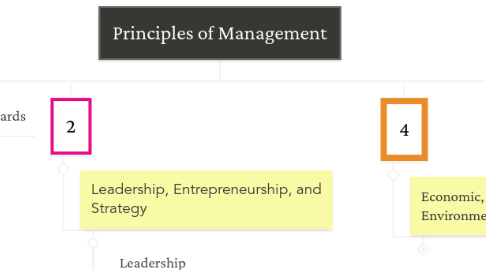
1. 1
1.1. Who Are Managers
1.1.1. Types of Managers
1.1.1.1. Top Managers: responsible for developing the organization's strategy (steward for the vision and mission).
1.1.1.2. Functional Managers aka Brand Managers: responsible for the efficiency and effectiveness of a specific area (i.e. accounting).
1.1.1.3. Supervisory Managers aka Team Managers: responsible for coordinating a subgroup with a particular function or a team composed of members from different parts of the organization.
1.1.1.4. Line Managers aka Product/Service Managers: lead a team the directly contributes to the products or services the organization creates (they serve important role in keeping assembly lines on track).
1.1.1.5. Staff Managers: leads a group that creates indirect inputs, they provide an advisory role.
1.1.1.6. Project Managers: responsible for the planning, execution, and completion of projects.
1.1.1.7. General Managers: responsible for managing a clearly identifiable, revenue-producing unit, i.e. a store or business line. (MICHAEL SCOTT OF DUNDER-MIFFLIN )
1.1.2. Nature of Managerial Work
1.1.2.1. 10 roles divided into 3 groups and are all interconnected:
1.1.2.2. 1) Interpersonal
1.1.2.2.1. Figurehead
1.1.2.2.2. Leader
1.1.2.2.3. Liaison
1.1.2.3. 2) Informational
1.1.2.3.1. Monitor
1.1.2.3.2. Disseminator
1.1.2.3.3. Spokesperson
1.1.2.4. 3) Decisional
1.1.2.4.1. Entrepreneur
1.1.2.4.2. Disturbance Handler
1.1.2.4.3. Resource Allocator
1.1.2.4.4. Negotiator
1.1.3. Roles are Changing:
1.1.3.1. Traditional:
1.1.3.2. Top managers ensure the organization's competitiveness and lower level managers' and employees' job security ________________________________________ Lower-level managers and employees implement top management's strategy with loyalty and obedience
1.1.3.3. Contemporary
1.1.3.4. Empowered lower-level managers and employees are responsible for the organization's competitiveness and their own development _________________________________________ Top Management support personnel development and ensure employ-ability
2. 3
2.1. Planning, Organizing, Leading, and Controlling
2.1.1. Planning
2.1.1.1. Environmental Scanning: The act of analyzing the critical external contingencies facing an organization in terms of economic conditions, competitors, and customers.
2.1.1.2. Strategic Planning: The process of analyzing competitive opportunities and threats, as well as the strengths and weaknesses of the organization, and then determining how to position the organization to compete effectively in its environment.
2.1.1.3. Tactical Planning: Intermediate-range planning that is designed to develop relatively concrete and specific means to implement the strategic plan.
2.1.1.4. Operational Planning: Assumes the existence of goals and objectives and specifies ways to achieve them.
2.1.2. Organizing
2.1.2.1. Job Design: The process of putting together various elements to form a job keeping in mind organizational and individual worker requirements.
2.1.2.2. Job Enrichment: A job redesign technique that allows workers more control over how they perform their own tasks.
2.1.2.3. Teamwork: Cooperative effort by the members of a group or team to achieve a common goal.
2.1.3. Leading
2.1.3.1. To become an effective leader one must first understand their subordinates' personalities, values, attitudes, and emotions.
2.1.3.2. COMMUNICATE YOU BIG DUMMY
2.1.4. Controlling
2.1.4.1. Step 2: Comparing actual performance against standards
2.1.4.2. Step 3: Taking corrective action when necessary
3. Step 1: Establishing performance standards
4. 2
4.1. Leadership, Entrepreneurship, and Strategy
4.1.1. Leadership
4.1.1.1. Definition: The act of influencing others toward a goal
4.1.1.2. Management requires good leadership and leaders
4.1.1.3. "There are two ways of exerting one's strength; one is pushing down, the other is pulling up." -Booker T. Washington
4.1.1.4. "The first job of a leader is to define a vision for the organization... Leadership is the capacity to translate vision into reality." -Warren Bennis
4.1.1.5. "A manager takes people where they want to go. A great leader takes people where they don't necessarily want to go but ought to." -Rosalynn Carter
4.1.1.6. "Managers have subordinate- leaders have followers." -Chester Bernard
4.1.2. Entrepreneurship
4.1.2.1. Definition: the recognition of opportunities (needs, wants, problems, and challenges) and the use or creation of resources to implement innovative ideas for new, thoughtfully planned ventures.
4.1.2.2. Entrepreneur is a person who engages in entrepreneurship... duh...
4.1.3. Strategy
4.1.3.1. Definition: The central, integrated, externally-oriented concept of how an organization will achieve its objectives.
4.1.3.2. Strategic Management: examines how actions and events involving top executives, firms, and industries influence a firm's success or failure.
4.1.4. Synchronizing The Above
4.1.4.1. It's all used to answer questions like "who," "what," and "how."
4.1.4.2. L- Helps lead the organization forward. E- Identify opportunities and problem solving (answers the "what" questions about the purpose of an organization). S- Makes sure right choices are being made.
5. 4
5.1. Economic, Social, and Environmental Performance
5.1.1. Economic Performance
5.1.1.1. Customers play a big role in economic profits
5.1.2. Social and Environmental Performance
5.1.2.1. Corporate social responsibility (CSR) is a concept whereby organizations consider the interests of society by taking responsibility for the impact of their activities on customers, suppliers, employees, share- holders, communities, and the environment in all aspects of their operations.
5.1.3. Integrating Economic, Social, and Environmental Performance
5.1.3.1. Balance and responsibility
6. 5
6.1. Performance of Individuals and Groups
6.1.1. Individual-Level Performance
6.1.1.1. In-role performance: The things that you have to do as part of your job and its job description.
6.1.1.2. Organizational citizenship behaviors (OCBs): Voluntary behaviors employees perform to help others and benefit the organization.
6.1.2. Group-Level Performance
6.1.2.1. Group: A collection of individuals who interact with each other such that one person’s actions have an impact on the other informal groups.
6.1.2.2. Team: A cohesive coalition of people working together to achieve mutual goals.
6.1.3. Compatibility of Individual and Group Performance
6.1.3.1. First: Look at goals, there should be compatibility between individual and group goals.
6.1.3.2. Second: Incentives need to be aligned between individuals and groups.
6.1.3.3. Third: Firms need to be careful to match their goals with their reward structures.
7. 6
7.1. Managing Learning Styles
7.1.1. Assess Your Learning Style
7.1.2. Gauge- Discover- Reflect (DUH)
8. 7
8.1. Doing Good As A Core Business Strategy
8.1.1. GOODWILL!!!...???
